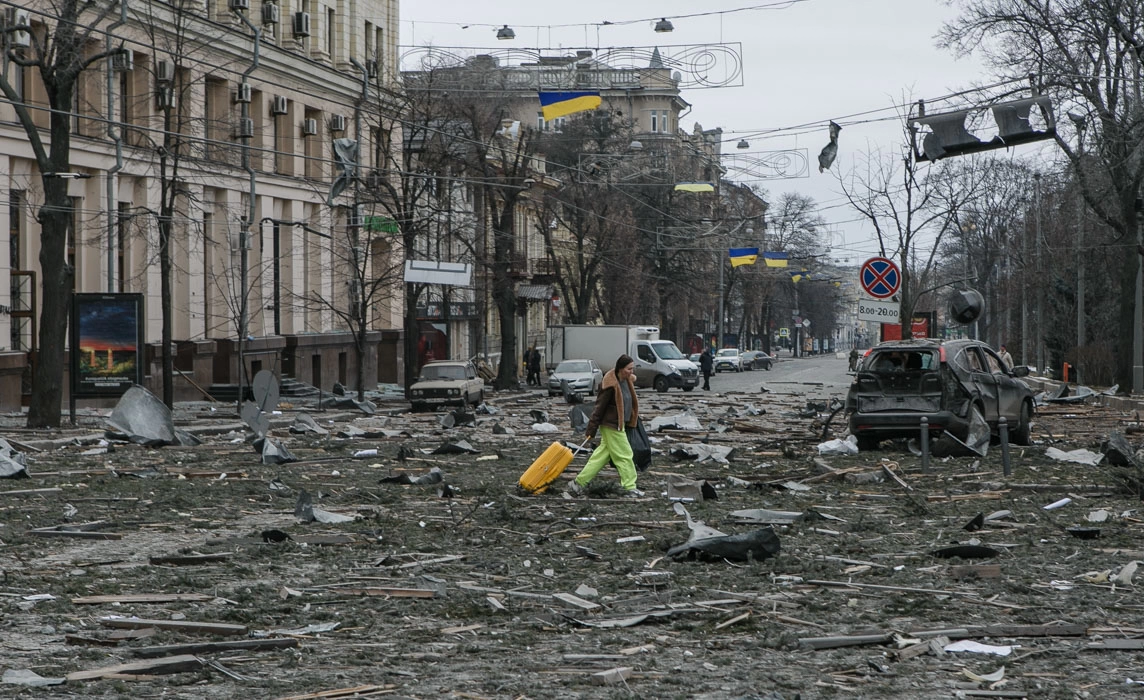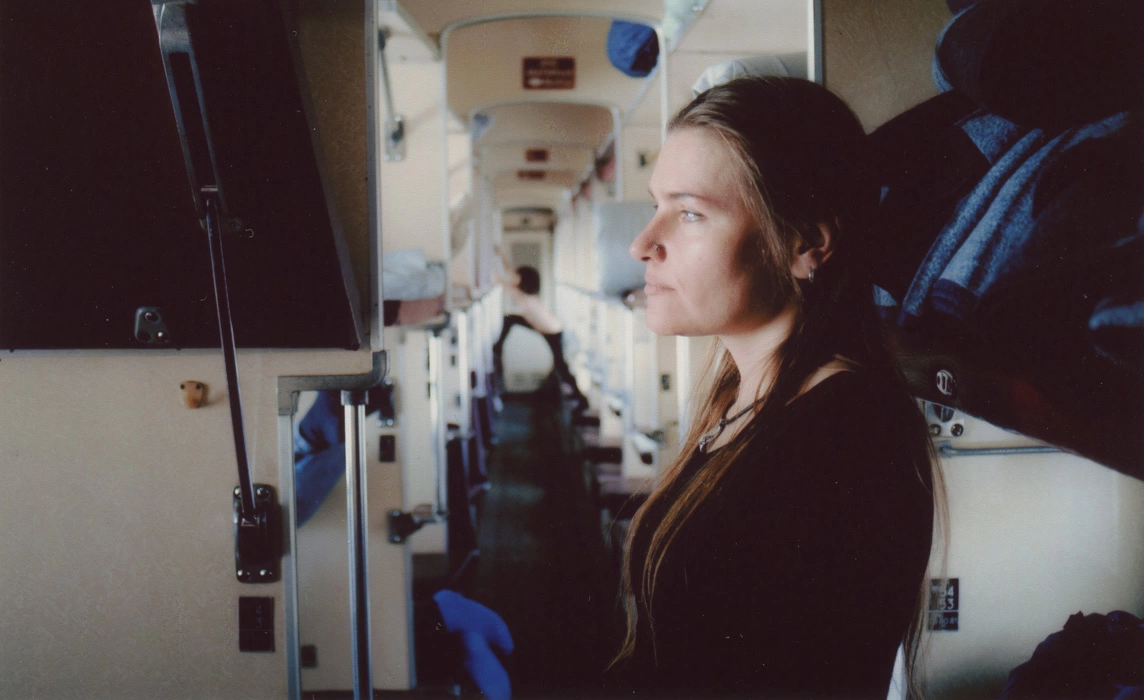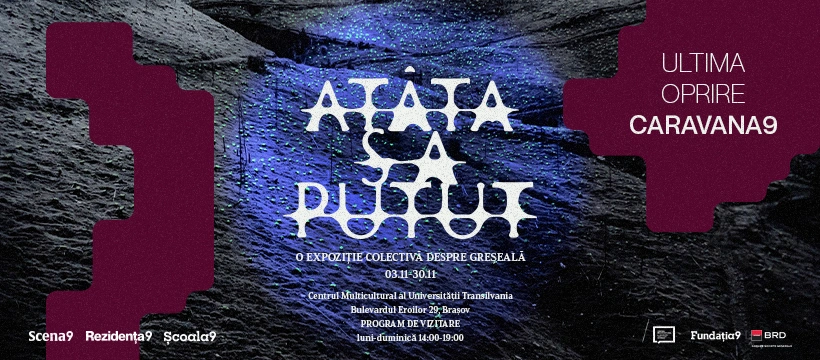“Killed alongside his wife and child,” “shot,” “killed during the bombing of the hospital where he was receiving medical care.” These are glimpses of some of the last moments of the Palestinian journalists killed in Gaza over the past almost two years. Journalists who, until their last breath, worked in hellish conditions: displaced multiple times, sheltering in tents, and weakened by hunger. When they survive, they’re left without fingers, hands, or legs, or they’ve lost their sight because they were shot in the eye. Others are out reporting when they receive the terrifying news from their colleagues that their entire family has been killed in a bombing. And when they don't find out beforehand, they return from work only to find their home razed to the ground and their family killed.
All of this is happening because one of Israel's policies during this genocide is to make it less visible – which is why it has killed approximately 12% of the journalists in the Gaza Strip and does not allow foreign journalists access to document what is happening there. In mid-June, Gaza was completely without internet and phone service for three days, after the last main fiber optic network was bombed, and some regions are still cut off. Palestinian journalists’ social media accounts are often either blocked or shadowbanned by tech giants or hacked by cybercriminals.
I spoke with a Palestinian journalist and with the Committee to Protect Journalists (CPJ) to better understand the horrific situation Palestinian media workers are facing and how this affects mass-media worldwide.
In early June 2025, Melanie O'Brien, the head of the world's largest academic association on genocide – the International Association of Genocide Scholars (IAGS) –, stated that Israel is committing a genocide in Gaza. In March 2025, a UN Human Rights Council report accused Israel of sexual violence and “genocidal acts” in Gaza. In December 2024, an Amnesty International investigation concluded that Israel is committing genocide against Palestinians in the occupied Gaza Strip. That same month, Human Rights Watch accused Israel of “the crime of extermination” and “acts of genocide”. Lawyer and UN Special Rapporteur for Palestine Francesca Albanese wrote two reports in 2024 highlighting the genocide in Gaza: “Anatomy of a Genocide” and “Genocide as colonial erasure”. Among the Israeli experts who denounce their state's actions a genocide are Omer Bartov, Daniel Blatman, Amos Goldberg, Lee Mordechai, Raz Segal, and Shmuel Lederman. In January 2024, the International Court of Justice ordered Israel to prevent genocidal acts in Gaza, in a provisional ruling that said that at least some of the claims against Israel under the genocide convention were “plausible”.
In the five weeks I’ve been working on this story, Israel has killed 20 Palestinian journalists and media workers, including an 11-year-old content creator. In the 20 months since the brutal assault on the Gaza Strip began, it has killed over 200 journalists and media workers – 226 at the time of publication, according to the Palestinian Journalists’ Syndicate’s latest figures (media workers such as fixers and translators offer support and expertise crucial for journalists). Also during this period, over 400 journalists have been injured and more than 600 family members of journalists have been killed. 10 Lebanese journalists and media workers have also been killed and several injured, including a Lebanese journalist who lost her leg.
The CPJ has been tracking journalist deaths worldwide for over three decades, and 2024 has been the deadliest single year over that timespan, with Israel committing almost 70% of these crimes.
“The Israeli army has killed more journalists in ten weeks than any other army or entity has in any single year. And with every journalist killed, the war becomes harder to document and to understand,” said Sherif Mansour, CPJ’s Middle East and North Africa program coordinator, in December 2023.
In his paper News Graveyards: How Dangers to War Reporters Endanger the World, from the Watson Institute for International & Public Affairs at Brown University in the United States, researcher Nick Turse points out that “The war in Gaza has, since October 7, 2023, killed more journalists than the U.S. Civil War, World Wars I and II, the Korean War, the Vietnam War (including the conflicts in Cambodia and Laos), the wars in Yugoslavia in the 1990s and 2000s, and the post-9/11 war in Afghanistan, combined.” “It is, quite simply, the worst ever conflict for reporters,” says Turse in his study, emphasising that in Gaza, an average of 13 journalists are killed per month.
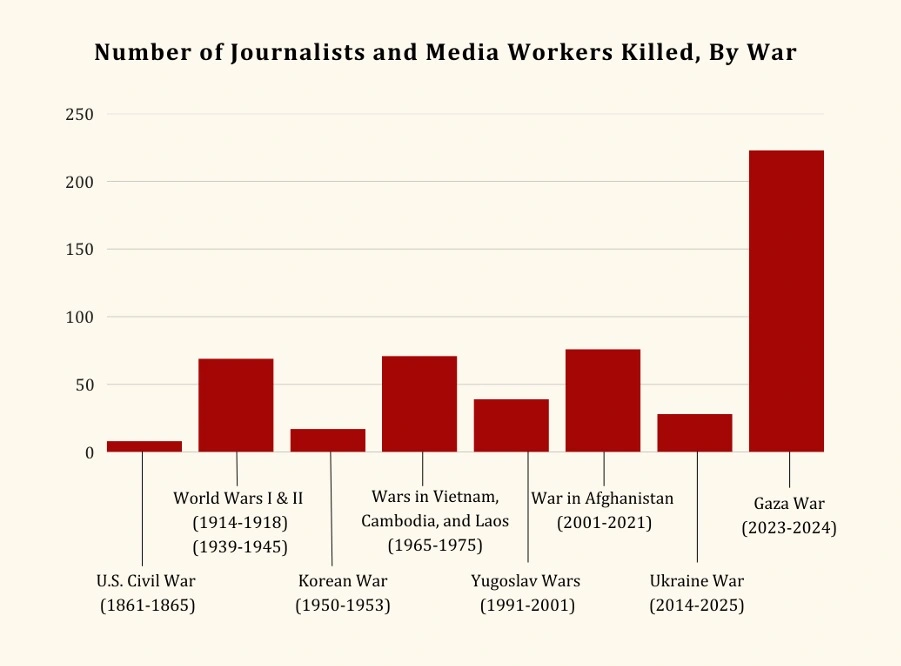
Turse's work recalls the death of journalist Samer Abudaqa (45 years old) in December 2023, who was reporting from a school bombed by Israel, alongside his colleague Wael Dahdouh. A new round of bombing caught the two journalists on site. Wael was injured but managed to escape. He had already lost his wife, one son, daughter, and grandson in another Israeli bombing, and then, in a drone attack, he lost another son, also a reporter for Al Jazeera. However, his colleague, Abudaqa, injured and immobilised, could not flee, and the Israeli army did not allow first responders to approach. Five hours later, when medics finally reached him, Abudaqa was no longer alive – he had bled to death.
“The issue is not delivering the story. The issue is that there is no action after all this information”
According to the Geneva Convention, journalists are civilians and must be protected from all forms of violence in war zones.
Killing, torture, enforced disappearance, arbitrary detention and arrest, expulsion, intimidation, harassment, threats and other forms of violence against journalists are considered abuses and violations of human rights.
Also, all media equipment and infrastructure are civilian, so it is illegal to destroy them.
The equipment that journalists wear in conflict zones (vest and helmet) is both to physically protect them and to signal to everyone else that they are journalists, and should therefore be protected.
Even with missing limbs or with the trauma of having lost their families, the Palestinian journalists who survive the attacks continue to do their work. But they no longer have any offices to work from, because Israel has destroyed 112 media institutions in Gaza, including the offices of the Associated Press, Reuters, and Agence France-Presse – practically all press offices in the Strip.
Having been left without newsrooms, they set up press tents in hospital courtyards, thinking that these were safe places to work from and where they would have electricity. However, after an Israeli attack on al-Aqsa Hospital on 31 March 2024, in which eight journalists were injured, CPJ program director Carlos Martínez de la Serna stated: “The attack on Al-Aqsa Martyrs Hospital and the 18 March attack on al-Shifa hospital, in which journalists were arrested and assaulted, have made even hospitals unsafe for the press, in addition to doctors, patients, and other civilians. Assaults on hospitals have made it so the press have even fewer places to work safely.” In the ground attack on al-Shifa Hospital, with soldiers and tanks, the Israeli army destroyed the journalists’ tent, equipment, and cars.
I spoke about the tragic situation in Gaza with Shuruq As’ad, a Palestinian journalist with 30 years of experience and a member of the Palestinian Journalists’ Syndicate. “All media organizations have been destroyed. Journalists thought they were protected inside their offices, now they don’t have offices. They went to the streets, they were attacked. They went to their homes, they were bombed. They went to schools, they were bombed. Inside the hospitals, also bombed. Now they are from tent to tent, from place to place, risking their lives to reach a very small signal of Internet to deliver maybe a 20-second video or article or even to find a place to charge their mobile phones,” Shuruq tells me.
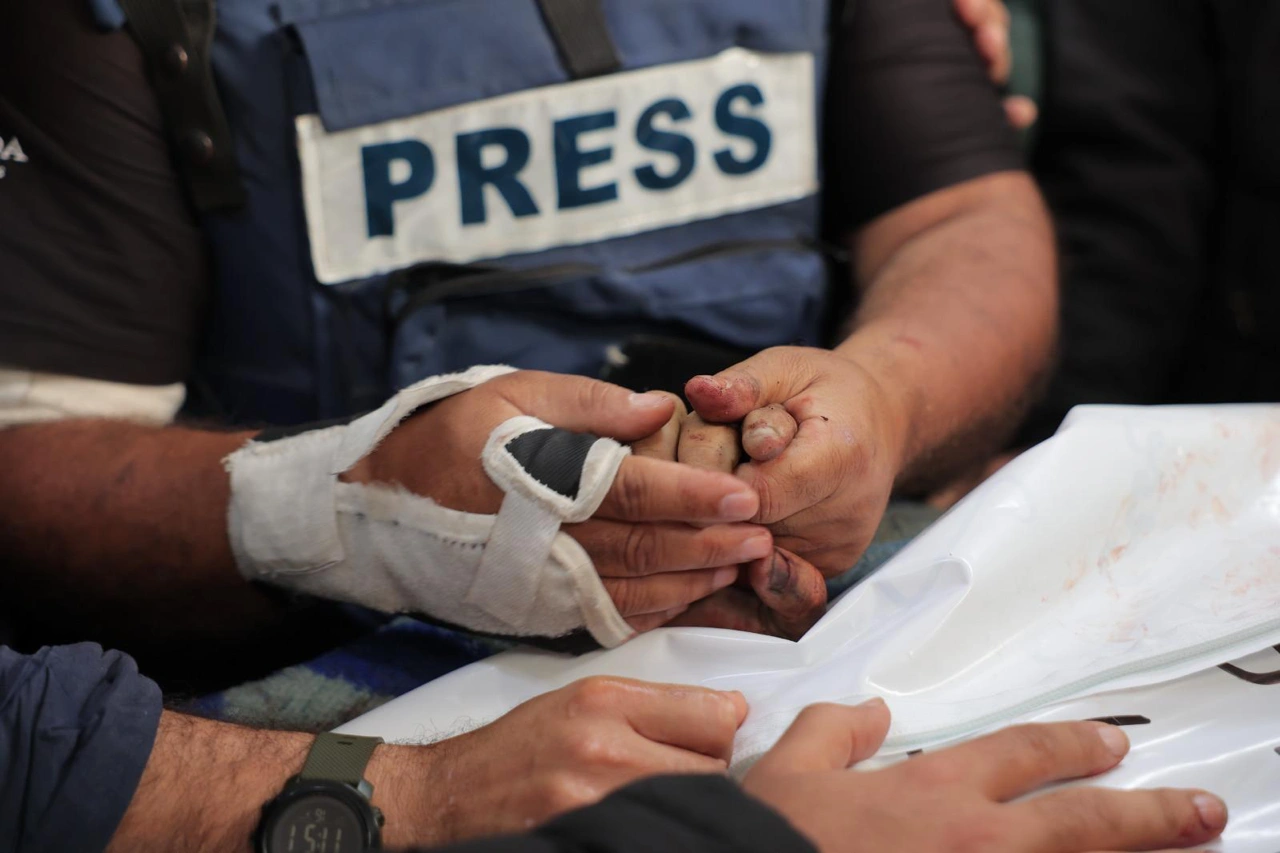
When bombing hospitals, the Israeli army claims it does so because they are used by “terrorists”, without offering evidence or presenting fake evidence. Just recently, on 13 May 2025, Israel conceded that the images of supposedly “Hamas tunnels” under the European Hospital in Khan Younis they released to justify bombing the building were, in fact, from another location nearby. This was the last hospital in Gaza providing cancer and cardiac care and, after the bombing, it was forced to close. “The repeated targeting of the hospital makes it impossible to provide medical care, as it poses a risk to medical staff, the wounded, and patients,” the staff said in a statement at the time.
Even when they are not killed in the attacks, the journalists still lose the expensive equipment vital for their work – cars, photo & video cameras, phones, laptops. And protective equipment (press vests and military helmets) is almost impossible to find. Given that 92% of homes in Gaza have been destroyed, most journalists, like the rest of the population, have been left homeless. Almost 1,800 journalists in Gaza have been displaced, some of them 10-15 times, and many are forced to search for food to survive. “I receive calls from my colleagues telling me, «We are hungry, we haven't eaten a piece of bread in a week, we need clean water,»” Shuruq tells me. On top of all this is the inevitable trauma that all war reporters face.
Moreover, most Palestinian reporters are not allowed to leave Gaza, and the few who do manage to do so are no longer permitted to return. Tareq S. Hajjaj, a Palestinian reporter who managed to take refuge in Egypt, describes in an article in Mondoweiss how the genocide has made even the most basic journalistic tasks, such as tracking down a source, almost impossible: “Now, families are scattered, addresses are non-existent as most buildings have been destroyed, and people now live amongst rubble or in a sea of tents.”
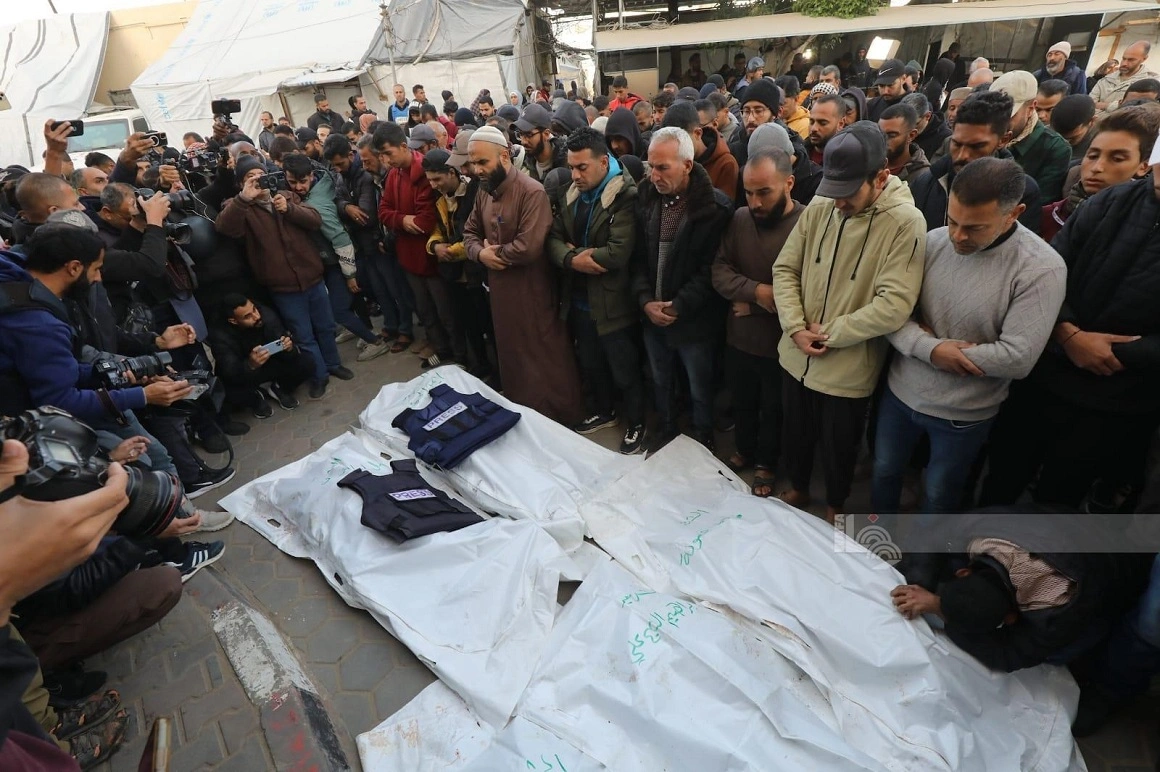
I asked Shuruq how her colleagues in Gaza still manage to do their jobs, given all the horrors they are facing. “They have no choice, they are both victims and journalists at the same time. It's very difficult, but it’s their life that they are covering. It’s their wish and goal that their pictures and the articles will end the suffering that they are living with their families. It’s their neighborhoods that are being bombed, their hospitals, their schools, their streets, their loved ones who are dying, their children who are starved. I’m in contact with them daily, this is their tool, they are journalists, this is what they can do. They still have hope that seeing this, the world will put pressure somehow and stop all this misery.” However, Shuruq adds that Palestinian journalists are disappointed, because regardless of what happens next, no one can bring back the lost lives. 80% of Gaza is destroyed and no one will be able to heal the collective trauma they are going through. “Gaza is not the Gaza that we know and we are not the same people who we were before,” the journalist tells me.
Shuruq also says there are no journalists anywhere else in the world working under the brutal conditions as her colleagues in Gaza. “And we learned a lot from them, to be frank, how to go on, how to find solutions, how to insist on delivering a picture or an article. And since all international media are banned, they are our eyes, they are our senses. Without them, we would not really know everything that is happening.” Nevertheless, some have given up their work – either they made the decision themselves, or their families convinced them, because they didn't want to let them be killed. “But the majority continued.”
The truth is affected, however, she tells me. “When you don’t have electricity or internet and you’re attacked, you will never be able to freely, peacefully deliver the whole story.” But she doesn't believe there will be a total media blackout in Gaza, no matter how much Israel wants it. “Each day we have new journalists coming on board. He may be a student who graduated recently, some people come from social media, others are researchers and transitioned to journalism. “The issue is not delivering the story. The issue is that there is no action after all this information.”
“Enforced disappearance”
One of Israel's strategies is the enforced disappearance of Palestinians with the help of the "Unlawful Combatants Law" in Gaza and "administrative detention" in the West Bank, measures through which they have esentially legalised hostage-taking – approximately 6,800 Palestinians are imprisoned, without a trial in accordance with international law standards and without their relatives knowing what is happening to them. Amnesty International has documented the case of 27 former such detainees, including a 14-year-old boy, who recount how they were beaten, sexually assaulted, and had dogs set on them.
This is what happened to journalists Nidal al-Wahidi (31) and Haitham Abdel Wahid (25), detained by Israeli forces on October 7, while documenting the attack led by Hamas’s al-Qassam Brigades. Two years later, their whereabouts are still unknown to family and friends, as well as the reasons for their abduction or even if they are still alive.
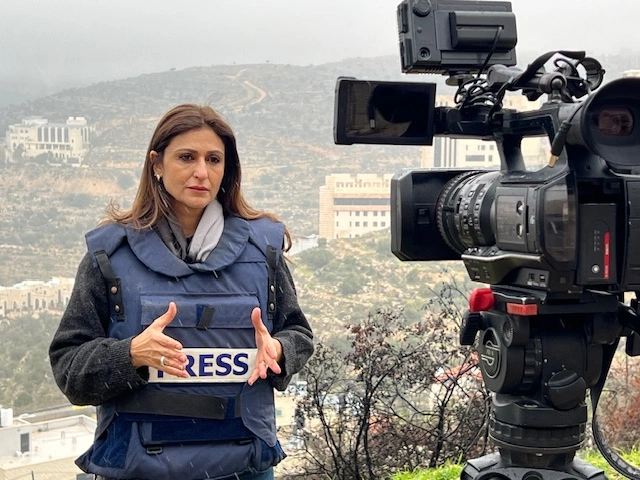
Just one day before I spoke with Shuruq, on May 13, Israel had killed another journalist – Hassan Aslih, who was 38 years old.
Hassan was murdered while recovering from another Israeli attack in the burns unit of Nasser Hospital in Khan Younis. On 7 April, a press tent near the same hospital had been bombed, killing two journalists – Hilmi al-Faqaawi (28) and Ahmed Mansour (35) – and injuring eight others. Images of Ahmed burning alive went viral. Hassan escaped with his life from that attack, but suffered a skull fracture, shrapnel wounds, severe burns on his body, and two amputated fingers. After more than a month of medical care, an Israeli kamikaze drone struck the third floor of the hospital where he was located, killing him in the hospital bed. “This was an assassination, plain and simple. He was immobile, lying in a hospital bed, no threat to anyone. The only weapon he ever carried was his camera. This was not a mistake. They knew exactly where he was,” said journalist Tamer Qishta – who had worked with Hassan in the past – after the attack. My colleagues and I were contacting him over the previous week, because we wanted to help him to have medical treatment. I didn’t sleep last night thinking that we were about to help him and Israel denied him and other colleagues to leave Gaza for medical help. We were engaging with him and we lost him in just seconds,” Shuruq tells me.
The Israeli army even admitted that the attacks on 7 April and 13 May on the hospital directly targeted Hassan, who, according to Israeli authorities, was a “terrorist”. As proof, they showed an image from 2020 of Hassan and Yahya Sinwar, the former Hamas leader, photographed at an event the journalist was covering. Israeli authorities also argued that Hassan had allegedly “participated in the October 7 massacre”, referring to a video of a burning tank that the journalist had shot in the Rafah area. However, his colleagues and relatives say that in both situations the journalist was just doing his job, being present where things were happening and documenting them.
Tareq S. Hajjaj, who had worked with Hassan, explains in a Mondoweiss article why the accusations against him are fabricated to justify his assassination: “During those 18 months, Hassan’s whereabouts were always well-known. From my experience working with him during this period, he was easily accessible via WhatsApp or phone call at all times, always based at journalists’ gathering points and never absent. Anyone with even a passing knowledge of Hamas and how the Qassam Brigades operate will instantly recognize how utterly incoherent the Israeli army’s claims are. But Israel is counting on people’s ignorance and gullibility to believe that a dedicated journalist who operates in the field 24/7 also moonlights as a Hamas fighter.” In one of their last conversations, Hassan predicted his death, telling Tareq that it wouldn't be difficult for the Israeli army to attack him while he was lying in his hospital bed.
Shuruq highlights the double standard applied to journalists in Palestine compared to those in Israel. All journalists in Israel have served in the army, so some of them “entered Gaza or Lebanon and bombed homes.” “Some of them appear on very right-wing TV shows saying «We have to kill them» or «We made a mistake for letting the Palestinians live until now.» So it's really very strange how this went on for almost two years and we are still justifying ourselves to the world that we are journalists. This is unfair and unethical.”
Before he was killed, Hassan had also spoken publicly about Israeli who embed with the army and post on social media photos of themselves with soldiers and destroyed buildings or relaxing in the homes of displaced Palestinians. Despite this, their status as journalists is not questioned. In October 2024, for example, journalist Danny Kushmaro concluded his 27-minute report on Channel 12, a centrist mainstream Israeli TV station, by pressing the button that detonated a house in Lebanon.
Hassan's colleagues say the real reason he was killed was his footage of the horrors happening in Gaza, as well as the testimonies of survivors. Many of the images he captured – especially those showing the scale of the destruction – went viral and showed the world Israel's destructive actions. Hassan, his colleagues recall, had the courage to go and film anywhere, no matter how dangerous it was.
“All of the journalists were killed either in the field, in the tents while working, in hospitals, in schools or in their homes. They weren't killed at all in a political meeting let’s say, as Israel claims. They were on the ground, working,” adds Shuruq.
In a press release in August 2024, CPJ criticized Israel's defamation campaigns against Palestinian journalists, used to justify their killing.
“The entire history of Palestine is one of dehumanisation”
Palestinian journalists often receive threatening messages on their phones or via social media telling them to stop reporting or to leave the area they are in. A few days later, they or their families are attacked.
“We're losing nearly every week a journalist or two. And it is a systematic target, it's not something by coincidence. Israel uses smart AI tools so they know exactly who they target,” says Shuruq. A 2024 investigation by Yuval Abraham in the Israeli publication +972 revealed how the Israeli army uses Lavender – an AI-based system. With the help of Lavender, the army created kill lists with tens of thousands of people who were to be bombed – usually at home, at night, with their families, because that’s where they were easier to locate. To find them, the Israeli army uses another system, called Where's Daddy?, which tells them when the “target” has entered the house, in order to bomb it. “The emphasis was to create as many targets as possible, as quickly as possible,” a source said in the investigation.
Hassan Hamad, who was 19 in October 2024, when he was killed, was also subjected to this intimidation tactic when he received a message telling him to “stop spreading lies about Israel”. The same thing happened to Anas al-Sharif, a reporter and videographer for Al Jazeera, who was threatened by the Israeli army on 22 November 2023 through phone calls and messages in which officers told him to stop his activity and leave northern Gaza. The journalist received WhatsApp messages in which members of the Israeli army showed him that they knew his location. On December 11, an Israeli bombing hit his house, killing his 90-year-old father.
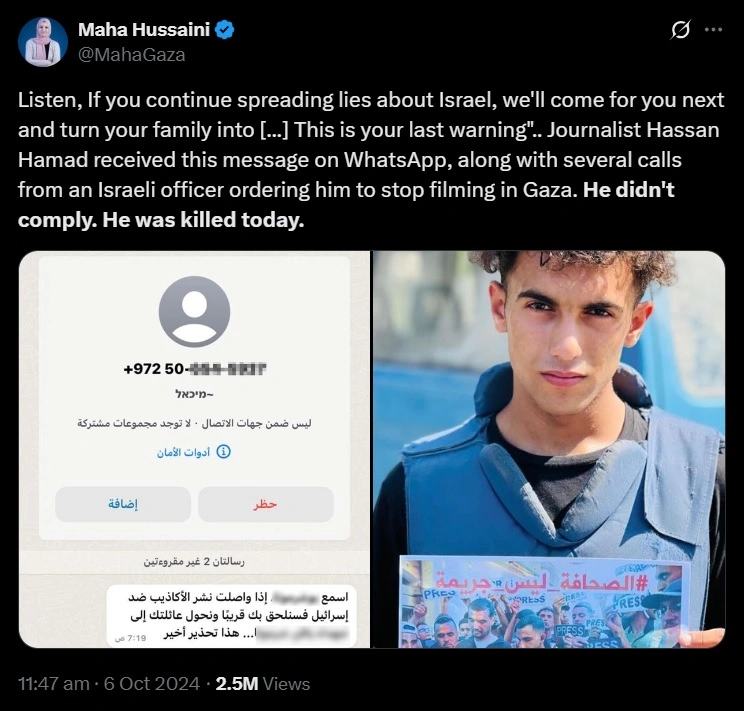
Sometimes it is difficult to determine which killings were targeted assassinations and which simply occurred because journalists were victims of the generalised massacre, like tens of thousands of Palestinian civilians. However, international organizations believe that some targeted killings can be confirmed by enough evidence showing that those journalists were attacked by Israel because of their work. A report by the international organisation Reporters Without Borders (RSF) mentions 35 Palestinian journalists killed as a result of their work, and CPJ says that at least 17 journalists and two media workers have been assassinated. The Committee is still analysing 20 other cases that they suspect were targeted attacks.
“The world has normalised death, massacres, killings. And the price of losing all those young colleagues is very high, most of them are young. It’s as if they are erasing a whole generation of journalists in Gaza,” says Shuruq. The average age in the Gaza Strip is approximately 18 years.
This normalisation of violence is also reinforced by artificial narratives, designed to drag Palestinian journalists into public disgrace. Before being killed, they are discredited through narratives claiming they helped combatants in Gaza or participated in the 7 October 2023 attacks on Israeli settlements around the Strip. Reporters Without Borders has documented an example of such a false narrative, which targeted Al Jazeera journalists Ismail al-Ghoul and Rami al-Rifi. The two were killed on 31 July 2024, while reporting from the commemoration of Ismail Haniyeh, former Hamas leader, who had just been assassinated in Tehran. The car in which the two journalists were, clearly marked as a press vehicle, was hit by an Israeli missile that killed them and a child nearby. The Israeli army then claimed that al-Ghoul was a terrorist (without mentioning Rami). As proof, it offered a list of names that dates to 2021 and which “was found on Hamas computers seized in the Gaza Strip”. This list allegedly included al-Ghoul, but, when RSF requested more details, the army replied that the information was confidential. The experts interviewed by RSF said that, without details or context, the accusations are highly uncertain.
The document “contained contradictory information, showing that al-Ghoul, born in 1997, received a Hamas military ranking in 2007 – when he would have been 10 years old,” said the CPJ representatives with whom I spoke last month.
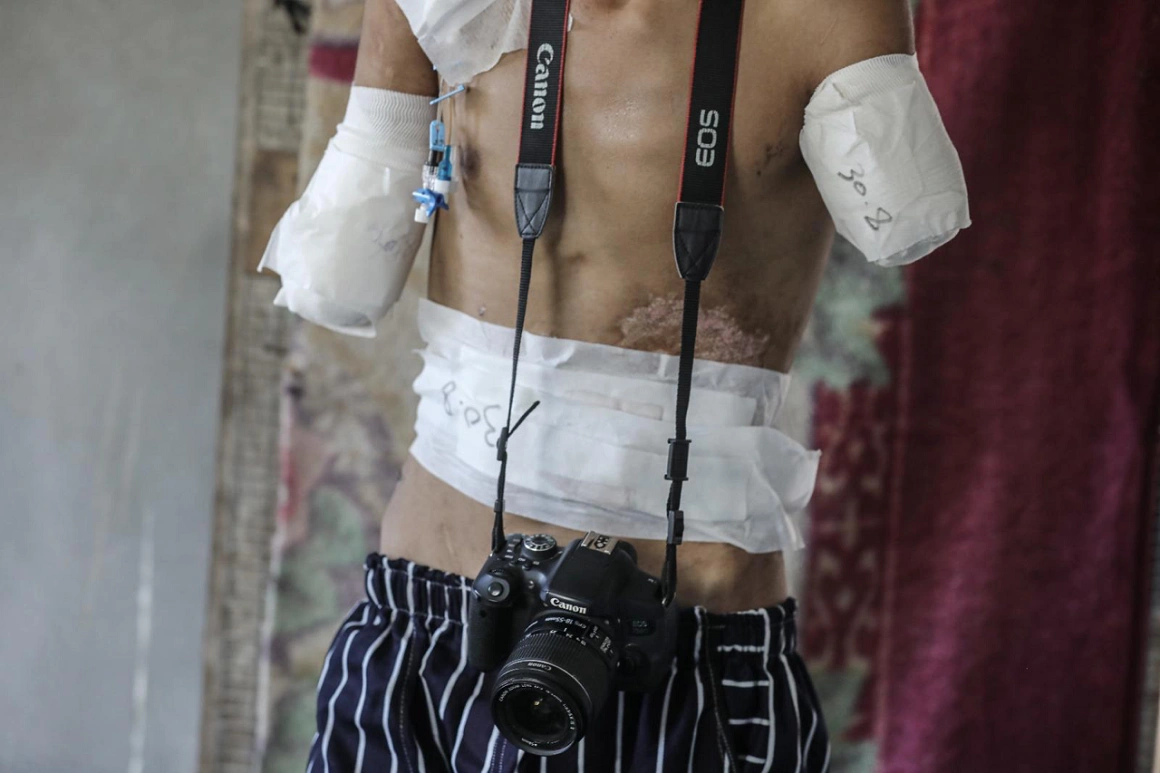
“All the time they claim that our colleagues are military targets, just as they say about doctors, teachers, kids. It's the same fake narrative of the whole story of Palestine – dehumanization. All the history of this place has to do with the same thing, dehumanization and lies,” Shuruq As'ad tells me. “And it’s really heartbreaking that even the international media keep on reposting this same fake news and investigating us all the time,” the journalist adds.
“CPJ reporting has found the Israeli military has a long history of denying responsibility and labeling journalists as terrorists. We know this practice endangers journalists and erodes public trust in Palestinian journalists reporting from Gaza. CPJ is aware of accusations made by the Israeli military against several journalists in Gaza accusing them of being members of militant groups. Israel has repeatedly made similar unproven claims without producing credible evidence,” reinforced Doja Daoud, CPJ's Program Coordinator for the Levant.
CPJ representatives also talk about how difficult it is for them to obtain firsthand information about attacks on journalists. “No one is documenting the aftermath of each strike, which gives us and the international community little or no evidence to work with. We have to rely on media reports which don't get into detail because killing is an around the clock story,” they told me. And not all cases can be documented, partly because 70% of Gaza is destroyed, and partly because journalists are killed along with their families and no one is left to provide information about the circumstances of their death. “The grave reality is that we have known of instances where whole families have been killed in strikes, leaving no one to contact to verify details of a journalist or media worker’s case.”
Although they are not killed with the same impunity as their colleagues in Gaza, journalists in the West Bank are also daily at risk of being assaulted or unjustly imprisoned. From October 2023 until now, Israel has detained 178 journalists, of whom 48 are still in prison. CPJ has documented 81 cases of Palestinian journalists in the West Bank arrested by Israel since October 2023. “From our research, we know these journalists are being arrested to get information from them. Almost all journalists released told us they were abused and asked several times about the information they have or their sources,” CPJ representatives told me.
“Israel says that they are killing our colleagues in Gaza because they are Hamas – though there’s no proof for this. So why are they attacking journalists in the West Bank? [under the Palestinian Authority, not Hamas] Soldiers entered journalists’ homes and brutally took them without saying why, put them in jails without a trial, where they were sexually harassed, tortured, starved, no visits allowed, not even from the Red Cross to get medical help. And the moment I say I am a journalist at one of the 900 military checkpoints, everything changes. Why do they ban us from doing our work?” Shuruq tells me. In the West Bank and Jerusalem, Israel has closed five media institutions; it has also destroyed or closed 12 printing presses in the West Bank.
Impunity for crimes against journalists
All these things were also happening before the genocide began almost two years ago. “It's not new, it just became more aggressive,” says Shuruq. “We lost 55 journalists, including three international journalists, between 2012 and 6 October 2023. And in the syndicate we have 10,000 cases of journalists attacked by the Israeli army or settlers in the same timeframe. And so many times we are attacked and we don’t report, so you can imagine that it is more than this.”
For example, in May 2021, Israel bombed a building in Gaza where the offices of the Associated Press and Al Jazeera were located. A year later, in May 2022, journalist Shireen Abu Akleh was shot in the head by Israeli forces while reporting on a raid in the Jenin refugee camp, even though she was wearing a press vest. Her death was resounding, both because she was a renowned Palestinian journalist who had worked for Al Jazeera for 25 years, and because she also held American citizenship. The very moment she was shot was caught on camera. Nevertheless, even then, no one was held accountable for the crime, and the United States downplayed the event. Although the US State Department’s analysis stated that the bullet that killed her was most likely fired by an Israeli soldier, the same department’s conclusion was that her killing was not intentional, but “the result of tragic circumstances”. “Shireen was my classmate in school and then we worked together. Her death was filmed, but there are many, many others. She represents many of our colleagues whom we lost,” says Shuruq.
In September 2022, after a brief investigation, the Israeli army stated that it was not possible to unequivocally determine the source of the bullet that killed her, but that there was “a high possibility” that Abu Akleh was “accidentally hit” by Israeli army gunfire.
CPJ report Deadly Pattern, published in May 2023, documented the cases of 20 journalists killed by Israel between 2001 and 2023 (18 Palestinians and two European correspondents), for whom no one was held accountable. Israel opened a criminal investigation into the killing of British journalist James Miller in 2003, while he was filming a documentary about the suffering of Palestinian children in Gaza, but closed it without prosecuting the soldier.
The Office of the UN High Commissioner for Human Rights stressed that Israel's Military Advocate General (MAG), the unit that should investigate these cases, is in a conflict of interest. MAG should investigate possible irregularities – occurring during operations for which MAG itself provided legal assistance.
“I have so many stories that I could talk non-stop. It's a daily thing and all my colleagues have stories like these, attacked either by settlers or by Israeli soldiers.”
“I was attacked so many times,” Shuruq tells me. “Every Palestinian journalist has a story, from before 7 October, of getting attacked, beaten, injured, tear gassed. We go to work every day not knowing if we will return home.”
The journalist remembers, for instance, that in 1998 she was interviewing Faisal Husseini, a well-known Palestinian politician, amidst protests taking place in Jerusalem against the construction of illegal Israeli settlements on Palestinian territories. “It was a very peaceful demonstration and it was clear I was a journalist. I was beaten and imprisoned, I have it all on camera. And when I told the Israeli police that I had images of the attack, they said «You are a liar, you faked this video.»” In 2001, Shuruq was at a demonstration in Ramallah with Raed – her cameraman colleague, who later became her husband – and a French reporter. Raed was filming an Israeli sniper who had his rifle pointed at the protesters. When the sniper saw the journalists, he pointed his gun at them. Raed shouted “Down!”, but the French reporter didn't manage to get down in time and was shot. “The soldier who shot him had one day's pay deducted from his salary,” Shuruq tells me.
In 2003, when Shuruq and her colleagues were reporting from a prisoner swap between Israel and Palestine, Raed was shot in the hand he was holding the camera with. "He was with our car that had TV stickers, they were wearing journalist gear. Israeli snipers shot 16 bullets at the car and one of the cameramen was shot, the bullet entered through his neck and exited through his cheek, his face was bleeding. And then they even shot at the ambulance that came for him.”
“I have so many stories that I could talk non-stop. It's a daily thing and all my colleagues have stories like these, attacked either by settlers or by Israeli soldiers.”
Israel wants to control the narrative
“I hope we will not lose another journalist,” Shuruq told me towards the end of our conversation. But the day after we spoke, on 15 May 2025, the very day the Nakba – the ethnic cleansing of Palestinians 77 years ago – was commemorated, Israel killed two more journalists. Ahmed al-Helou (34) died in the tent where his family lived, in a series of night bombings in the Khan Younis area, which killed a total of 50 people. The same bombings also hit the home of Hassan Samour (44), located 2 kilometers from Khan Younis. Hassan, who worked for al-Aqsa Radio, was killed along with 11 other members of his family (his wife, his five children, his mother, his brother, his brother's wife, and their children). Hassan's sixth child, and his brother's entire family, had been killed in a previous attack, so as of 15 May the entire Samour family has been wiped out of existence.
After four more journalists were killed on 18 May, three of them along with members of their families, the Palestinian Journalists’ Syndicate issued a press release stating that such attacks constitute “acts of terrorism and crimes against humanity, and the silence of the international community and human rights organizations and the inaction of UN institutions amount to clear complicity with the executioner, giving the killer more green light to commit further massacres against the free press. Palestinian journalists will continue their mission, even if it means each journalist must carry their own coffin on their back while covering scenes of massacre.”
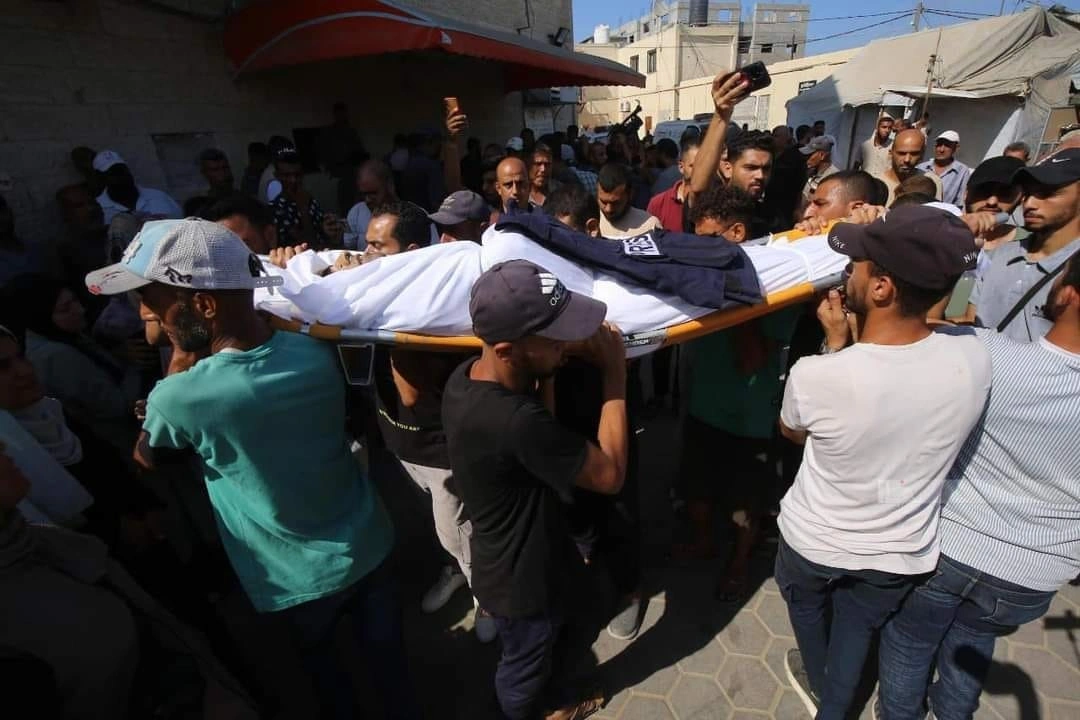
On 5 June, another Israeli bombing killed three journalists and injured four others in the press tent set up in the courtyard of al-Ahli Hospital in Gaza. On 10 June, Moamen Abu Alouf (19) was documenting the work of paramedics evacuating the victims of a bombing when a second Israeli missile killed him and three of the doctors.
“Israel’s attacks on the press are an effort to silence the messenger and the reality of daily life in Gaza. The international community's failure to uphold press freedom in Gaza, pressure Israel on journalist safety, or conduct criminal investigations into potential war crimes in Gaza, means Israel has been emboldened to continue its assault on the press,” Doja Daoud, CPJ's Program Coordinator for the Levant, told me.
Nick Turse, the author of News Graveyards, points out that attacks on journalists fuel long-term changes on mass-media – the deprioritisation of international news coverage and the closure of foreign news bureaus. “Across the globe, the economics of the industry, the violence of war, and coordinated censorship campaigns threaten to turn an increasing number of conflict zones into news graveyards, with Gaza being the most extreme example,” Turse writes.
“After years of resentment over international coverage of its wars with Hamas, the Israeli government has unleashed an unrelenting war on the press. Since October 2023, Israel has barred independent foreign correspondents from Gaza while killing local journalists in record numbers – and without any repercussions,” the researcher writes. In other words, Israel wants to control the narrative by killing those who would tell the story of the Palestinians.
Israel does not allow foreign journalists access to Gaza to document what is happening there. The only journalists who have been able to enter are those who have embedded with the Israeli army, which controls what they can see.
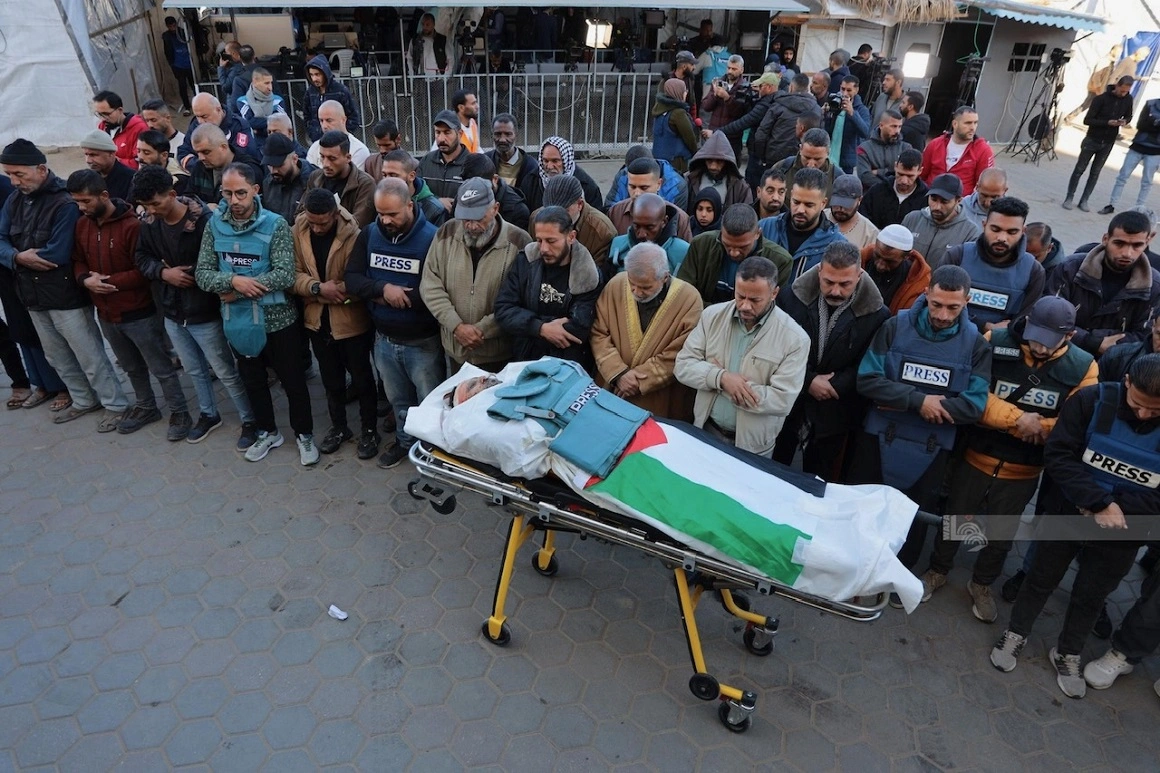
“Nobody from the international media has ever delivered from day one, from 1948 till now, the whole story in an ethical way. It was what Israel sees, what Israel thinks. Nobody asked «What is going on? What happened? Why are those people resisting?» We don’t want the world to be with Palestine, but we want them to be with human rights and with international law and to practice the ethical journalism that the West has always lectured us about,” Shuruq also told me. “Everybody will pay the price when humanity is attacked. It's not on Palestinians alone. And these attacks on journalism are not attacks on Palestinian journalists alone, but also attacks on human rights and journalism worldwide. When I, as a human being, accept children burned alive journalists and doctors murdered, it is simply an attack on humanity,” the journalist adds.
“The complete impunity Israel has experienced for killing journalists over decades has implications outside of this current war. Gaza journalists are exhausted and have lost trust and faith in everyone. Each time a journalist is killed in Gaza in this war is not only an attack on their family, the Gazan media community, and the truth, but also on the foundation of human rights,” says Doja Daoud.
*
With each journalist killed, we know and understand less about the world, and oppressive regimes gain ground in their struggle to impose their own version of the truth. It saddens me to see the passivity of Western journalists, including Romanian ones, in the face of the killing of their Palestinian colleagues with no one being held accountable. If for lack of empathy or professional solidarity, at least out of cynical self-interest they could use their voice to speak out against this injustice. Earlier this month, a journalist reporting from the Los Angeles riots was shot by police with a rubber bullet, and press freedom worldwide is declining, including in countries where it used to be respected. Anyone who believes that the normalisation of attacks on journalists in the Middle East will not have repercussions at home is naive.
Opening photo: WAFA Agency

